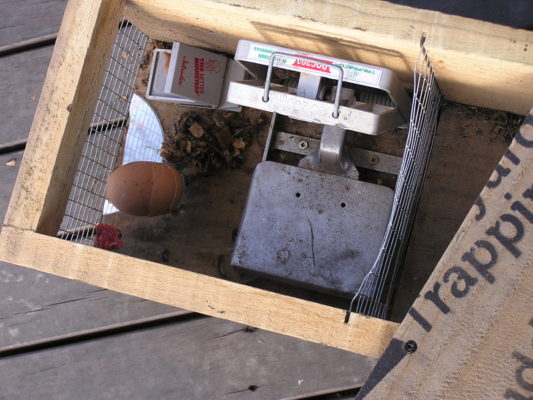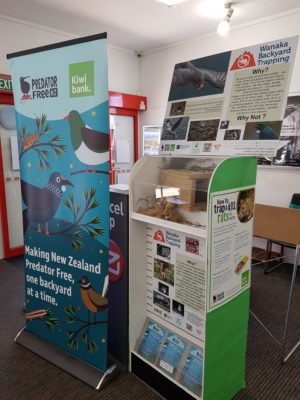Since forming in Feb 2018, the Wanaka Backyard Trapping Group has been going from strength to strength.
“The Post Shop approached us about putting up a display,” explains the group’s co-ordinator, Kris Vollebregt. “It was great. Customers were all standing in the Post Shop queue line by the display – it’s a captive audience! The display is going into the library next,” she adds. “We’ve also got a Facebook page and we’re putting together a website which will go live in the new year.”

The Wanaka group has given talks to other local groups and schools and has held four advertised public workshops for interested backyard trappers.”
“There are two streams to what we do,” Kris explains, “trapping on public land and on private land, which is the part that is supported by Kiwibank Predator Free funding. We advertised and held four workshops for people interested in backyard trapping and made traps available at the workshops.”
The workshops were a recruitment success and the group now has only the last few backyard traps left.
The Wanaka Backyard Trappers also took part in the recent ‘Eco-fair’ held one Saturday in the Lake Wanaka Centre, where, along with a Predator Free banner, DOC 200 and rat traps and a taxidermied weasel were on display.
Local pest controller, Billy Barton has been a key part of the group, sharing his trapping expertise since the beginning.

“The original idea was to have a ‘trap library’, but we decided that was not the concept we wished to follow,” says Kris. “People need to be in it for the long haul. As a local trapper, Billy had been thinking the same thing – trapping on public land around Wanaka.”
Billy, Kris and representatives from the Department of Conservation, Queenstown Lakes District Council and other community conservation groups got talking and the genesis of an urban Wanaka trapping group was formed early this year.
“We held our first meeting in February this year to form a committee and we received Kiwibank Predator Free funding soon afterwards.”
As a relatively new group on the predator control map, Kris and the other Wanaka volunteers are keen to learn from the experience of other urban groups.
“I’d like to ask other groups how they measure success,” Kris says. “It’s important for funding and for reporting back to the public. There are a variety of ideas – 5-minute bird counts, incidental noting, using the garden bird survey… we’re working towards data collection and monitoring our level of success but we are still considering the best method of doing this.”
Seasonal factors can complicate the picture too.
“At the moment there are lots of possums. It’s dry in Wanaka with lots of rabbits. Last summer was endless and hot and there were a lot of tui and kereru around the Upper Clutha area; now this spring everything is flowering amazingly – so the numbers of wildlife are responding to factors other than just predator numbers it seems.”
On the public land component of their urban trapping programme, the group uses DOC 200 traps to catch rats, stoats, ferrets and hedgehogs. They believe a feral cat strategy needs to be dealt with at a district or national level.
The group’s area of interest is the Upper Clutha urban and it’s peri-urban areas, not just urban Wanaka.
“We’ve put out 20 traps on the Lake Hawea foreshore where there was already a volunteer group sent up based on foreshore plant restoration,” says Kris. “A second project has just gone out with 15 traps around Albert Town lagoon. Ecologically it’s really interesting. It’s a little oxbow lake, an isolated remnant of the Clutha river. There are really interesting waterfowl living there – shags, teals, coots, and shovellers.”
Next up on the public land project list is Mt Iron.
“Mt Iron is a dominant geological feature on the eastern edge of Wanaka township,” says Kris. “It is a popular visitor and locals’ morning walk and is partly farm and partly DOC land. We’re going to put 35 traps out on the DOC owned part of Mt Iron.”
As other community groups will know, it’s not just a matter of sourcing your traps and putting them out.
“Each project on public land to date, is in collaboration with Queenstown Lakes District Council or DOC,” Kris explains. “There has to be clear warning and information signage for the public, as well as Health and Safety guidelines for the volunteers who maintain the traps and so on. It all has to be coordinated.
“Those taking part in our Kiwibank Predator Free backyard trapping are required to register their trap with our project on Trap.NZ, which is where we record our catch data,” says Kris, “though not everyone has done so yet, for whatever reason. But not everyone wants to put their information into TrapNZ.”
The group is also keen to hear from local longtime trappers.
“We’ve got to look at the big picture,” Kris emphasises. “It’s about keeping our native environment alive and thriving.”

